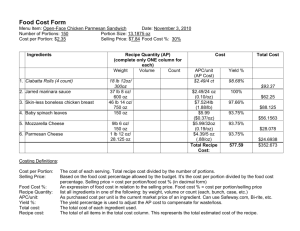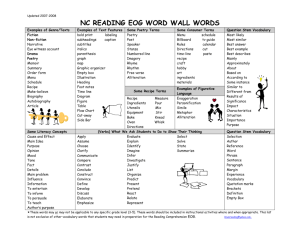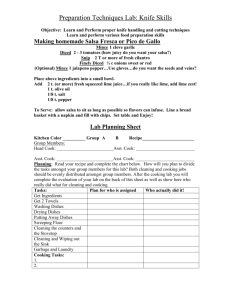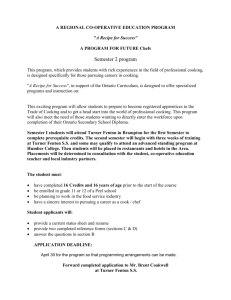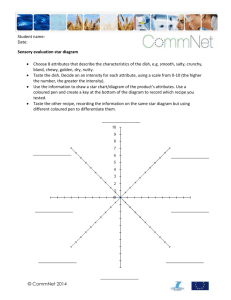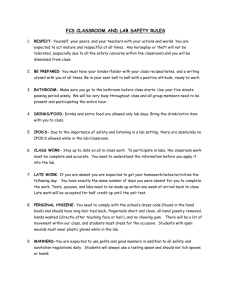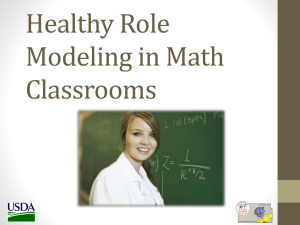10 Steps to a Healthier Me - Oregon State University Extension
advertisement
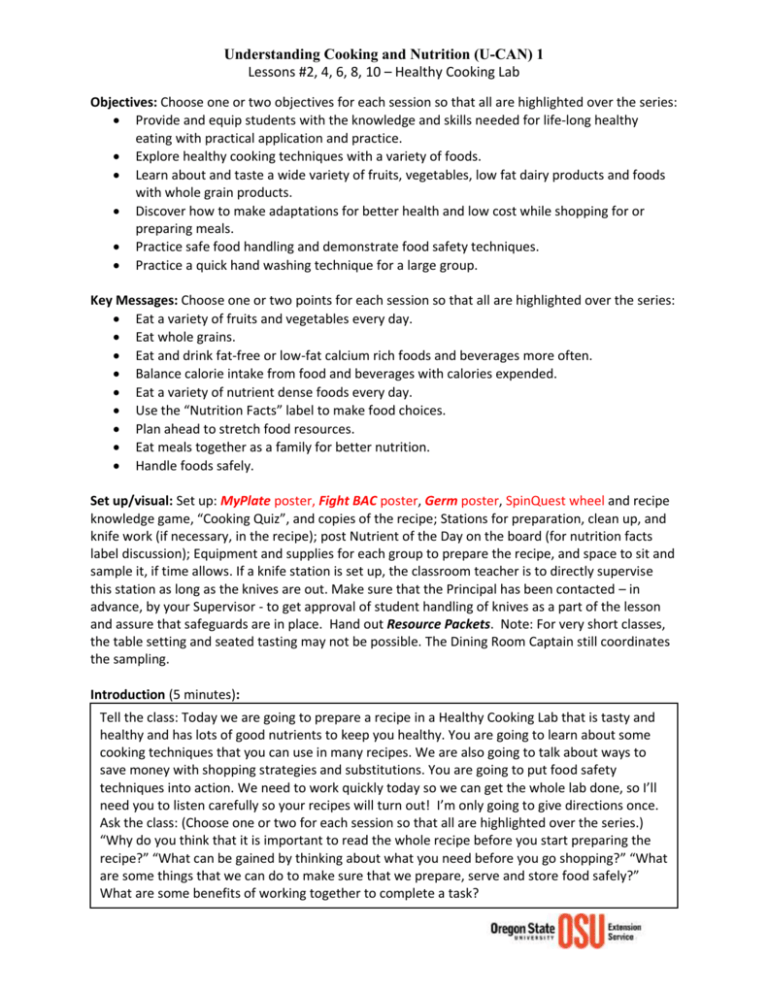
Understanding Cooking and Nutrition (U-CAN) 1 Lessons #2, 4, 6, 8, 10 – Healthy Cooking Lab Objectives: Choose one or two objectives for each session so that all are highlighted over the series: Provide and equip students with the knowledge and skills needed for life-long healthy eating with practical application and practice. Explore healthy cooking techniques with a variety of foods. Learn about and taste a wide variety of fruits, vegetables, low fat dairy products and foods with whole grain products. Discover how to make adaptations for better health and low cost while shopping for or preparing meals. Practice safe food handling and demonstrate food safety techniques. Practice a quick hand washing technique for a large group. Key Messages: Choose one or two points for each session so that all are highlighted over the series: Eat a variety of fruits and vegetables every day. Eat whole grains. Eat and drink fat-free or low-fat calcium rich foods and beverages more often. Balance calorie intake from food and beverages with calories expended. Eat a variety of nutrient dense foods every day. Use the “Nutrition Facts” label to make food choices. Plan ahead to stretch food resources. Eat meals together as a family for better nutrition. Handle foods safely. Set up/visual: Set up: MyPlate poster, Fight BAC poster, Germ poster, SpinQuest wheel and recipe knowledge game, “Cooking Quiz”, and copies of the recipe; Stations for preparation, clean up, and knife work (if necessary, in the recipe); post Nutrient of the Day on the board (for nutrition facts label discussion); Equipment and supplies for each group to prepare the recipe, and space to sit and sample it, if time allows. If a knife station is set up, the classroom teacher is to directly supervise this station as long as the knives are out. Make sure that the Principal has been contacted – in advance, by your Supervisor - to get approval of student handling of knives as a part of the lesson and assure that safeguards are in place. Hand out Resource Packets. Note: For very short classes, the table setting and seated tasting may not be possible. The Dining Room Captain still coordinates the sampling. Introduction (5 minutes): Tell the class: Today we are going to prepare a recipe in a Healthy Cooking Lab that is tasty and healthy and has lots of good nutrients to keep you healthy. You are going to learn about some cooking techniques that you can use in many recipes. We are also going to talk about ways to save money with shopping strategies and substitutions. You are going to put food safety techniques into action. We need to work quickly today so we can get the whole lab done, so I’ll need you to listen carefully so your recipes will turn out! I’m only going to give directions once. Ask the class: (Choose one or two for each session so that all are highlighted over the series.) “Why do you think that it is important to read the whole recipe before you start preparing the recipe?” “What can be gained by thinking about what you need before you go shopping?” “What are some things that we can do to make sure that we prepare, serve and store food safely?” What are some benefits of working together to complete a task? Content/Activity (40 to 65 minutes, total): Activity #1: Prepare recipe, sample it and clean up. 1. Make arrangements ahead of time for students to share a sample with other adults in the school. This increases the pressure to do good work with a real live application of their skills and to get instant feedback on their efforts. 2. Arrange students into four groups of 5-7. 3. Outline expectations: (5 minutes for the first time, then shorter) a. Everyone in your group needs to participate in both the preparation and clean up. You will need to work together by talking to each other and double checking with each other. One mis-measurement can cause ruin! You can write on your recipes with notes about who will measure each ingredient or do each task. Select a leader to make sure everyone has fair participation in the recipe preparation, table setting and clean up. Select a sanitarian to monitor safe food handling practices at every step and coordinate the clean up. Select a dining room captain to coordinate the table setting and serving effort. The leader, sanitarian, and dining room captain will change each week. Remember to lead with a smile. b. Clean as you go, sign of a pro! Set up (or know about) your clean up station, use it as you go instead of saving all clean up for later. c. You must sit as a group to taste your samples. Set the table with a place setting while the food is being prepared that includes the napkin, flatware needed, plate (or bowl), and cup of water. You do not need to eat the sample, but you are encouraged to take a taste. One of your samples can be delivered to ___ (other adult in the school), once you have finished your tasting. While tasting talk about how you can modify this recipe with other ingredients that you might have on hand or that you would like to try. Also discuss your team effort. Does your team work well together or do you need to make some modifications? There is a difference between fair and equal–is everyone contributing a fair share of effort? d. The leader and one other person can deliver the sample, and the Sanitarian coordinates the clean-up effort. They need to hurry back so that they can also help with clean up. e. Whenever food preparation occurs, there are tasks that someone doesn’t like to do. As a group you need to find a fun way to work together to get all the tasks done. Slackers may lose the opportunity to participate in these cooking labs in the future. Your group will be expecting a fair effort from you or they may have the opportunity to vote you off the island! Now think about fun things that you can do to make clean up more fun…singing or telling jokes, adding a little extra soap so you have more bubbles (think Fantasia), but also remember safety by not getting them all over each other, the table and the floor (again, think Fantasia). And, remember that we want to get this done quickly with the equipment looking as good or better than when you started. Great teams will be recognized (bring some stickers or food stamps with ink to decorate their recipes). 4. Read the recipes and wash hands. (6 minutes) a. Hand out recipes to all groups. In their groups have students read aloud using volunteers or “Popcorn” reading technique (students read as long as they like, but can stop at any time and say “Popcorn” and choose another student to continue reading). Read the whole recipe before they divide up the tasks. Have them underline major facts or directions that need clarification. Select group leaders. Work as a team to divide up the tasks. b. Concurrently, have groups take turns getting their hands washed. 5. Quick Demo: Point out or demonstrate key techniques and terminology. (no more than 4 minutes) a. E.g. how to measure liquid; the difference between a teaspoon and tablespoon – with a caution to have someone double check each person that measures an ingredient; a good time to “clean as you go”; how to separate an egg; how to hold and use or clean a knife properly; how to set up a cleaning station”. Use your recipe to determine the skill demonstrated. Recipes should build on skills, adding new ones each week. b. Ask if anyone needs a question answered about the recipe. 6. Look at Nutrition Facts label (3 minutes) a. Is there a vitamin, mineral or fiber that has at least 10% of the daily value? Discuss why this “nutrient of the day” is important for a healthy lifestyle. See SP50-876 Nutrients You Need. b. Write one or two nutrient functions on the recipe. 7. Prepare, sample and clean up (12 to 30 minutes – shortest, the first time) a. Tape the recipes to the wall, store Resource Packets in a safe area away from food preparation or clean up. b. Check to make sure that they have all their ingredients, equipment and supplies. c. Start preparation. d. Visit each group, check on leadership assignments, fair distribution of tasks, with every one participating in preparation, cleaning and table setting. Time gaps? Have some of each group do the Cooking Quiz (see Activity 2). e. Classroom teacher needs to “man the knife station,” if one is used. f. Sample the recipe; deliver the sample to the other adult in the school g. Clean up and stow or reset for the next class. Activity 2: “Cooking Quiz” (held concurrently) 1. “Cooking Quiz” SpinQuest is in an area away from cooking and cleaning. 2. Create questions developed from key points in the recipe, directions given in print or verbally, and about the purpose of the “nutrient of the day.” Questions should be prearranged on wheel using colorful background. 3. Students that are waiting for their turns for an activity or finished with clean up can spend time quizzing each other on key points. Closing (5 minutes): Ask: Would you share one thing you learned today? (If you have time, review the lesson with the SpinQuest Cooking Quiz. State: Selected Objective and Key Message from above Supplies and Equipment needed for the Activities Resource packet: o Copies of recipe for each student: Add to Resource packet. o SP50-876 Nutrients You Need o Optional handouts from Live Well Tool Kit: Live Well! Tips to Slip More Nutrients into your Meals, pg 8-10; Live Well! Eating the Nutrient Rich Way – On the Go, pg 11; Live Well! Eating Away from Home, pg. 12; Live Well! Fitting in “fun” foods, pg 13; Shop the Perimeter of the Store and Live Well! Nutrient Rich Shopping List Expectations poster – created from lesson content Tape to put recipes on wall to keep them clean. Equipment, supplies and ingredients to prepare and sample the recipe. Stickers or rubber food stamps and ink pads to reward cooperating teams “C” is for Correct Cutting Knife Skills Instructions http://extension.oregonstate.edu/deschutes/enjoying-our-healthy-harvest Extended Learning Suggestions: Assign students a nutrient to create a report on why it is important in a healthy diet, what foods are good sources and how they can improve their consumption to help prevent a chronic disease. The report can be written, spoken, a poster, a commercial, or a skit. A persuasive speech with props can be recorded and aired during guide room or announcements to improve consumption of a variety of foods (reducing some types of food consumption could be appropriate with teacher permission). After reviewing the Live Well! Tips to Slip More Nutrients into your Meals handouts, pages 8-10, create a menu plan that includes at least two suggestions for each meal. Review the eating out handouts from Live Well! Kit, page 11 and 12. Write a paragraph on how they could implement two changes for better health. Oregon Standards for 2013-14 School Year: Health Skills and Concepts Instruction: Demonstrate safe food preparation and storage practices (Self-Management). Advocate for the use of proper food purchasing, preparation and storage to keep food safe (Advocacy). Make a decision to eat foods that optimize health and well-being (Decision-making). Supplemental information: COOKING LAB EXPECTATIONS Work cooperatively in Groups Read the whole recipe, make notes and underline key information Everyone helps prepare the recipe, table setting and sampling and clean up Work as a team with a Leader, Dining Room Captain, and Sanitarian coordinating the fair participation by all the group members. Know what the recipe says and help others follow the directions Sample and analyze the recipe Clean as you go, sign of a pro Have fun and be safe Work quickly and cooperatively to get done on time Time to spare? Check out the SpinQuest wheel Successful Strategies: Healthy Cooking “Lab” in High School Health Classes Tips: 1. Arrive with plenty of time to set-up cooking “stations” prior to each session. Number of stations may vary from school to school and class to class, but 3-4 stations usually works well. 2. Locate electrical outlets (and risk of tripping breakers) and determine number of extension cords and appliances needed in advance. 3. Choose recipes that will fit into time frame available and that will allow enough time for hand washing, clean-up, and to do any demos planned. 4. Choose a relatively simple recipe for first lesson in order to ensure adequate time for first-time glitches and also to explain clean-up expectations and process (i.e. 3 compartment sink system). 5. Explain to class importance of following a recipe (i.e. read instructions before starting and paying close attention to measurements such as teaspoon vs. tablespoon). This point will need to be reiterated at the beginning of each cooking session! 6. Plan appropriate time for demos (i.e. cutting, knife safety, separating egg white, or anything else that seems appropriate to demonstrate). Using a trolley cart for demonstrations works very well. 7. Reiterate food safety messages throughout cooking sessions when appropriate and especially before any cooking session when raw meat/poultry/eggs are being used (i.e. preventing cross contamination, proper hand washing, cooking to appropriate temperature, etc…). 8. During “down” time when food is cooking, etc…groups can clean-up stations and/or participate in SpinQuest activity (see # 9). 9. SpinQuest option: post questions pertaining to specific recipe being made and/or general food safety and cooking questions. Students can visit the SpinQuest wheel during “down” times and also if extra time is available at the end of each cooking session. 10. Optional: Provide Health 1 students with “Cool Fuel” cookbooks and provide Health 2 students with “Your Guide to Eating More” Cookbooks. It is a good idea to use at least one recipe from each book! Suggested Recipes and Recipe Resources We suggest doing the same recipes in U-CAN 1 and U-CAN 2 each year. It will simplify your day. Rotate them each year so students that take the Health 1 as freshmen or sophomores will get a different recipe when they take the Health 2 class. 1st Lab, Easy Recipes Year 1: Popeye Power Smoothie/Peach Yogurt Smoothie/Orange Delight Year 2: Fruit parfait with Skillet Granola Year 3: Banana-Berry Smoothie/Banana Bobs Food Group Recipes Year 1: Tasty Hamburger Skillet Year 2: Ham & Vegetable Chowder Year 3: Chicken Broccoli & Cheese Skillet Meal Calcium Recipes Year 1: African Peanutty Stew Year 2: Pear Quesadilla Year 3: Skillet Mac & Cheese with frozen broccoli Low Fat Recipes Year 1: Chicken Enchilada Soup Year 2: Chicken & Black Bean Salsa Burrito (warm in skillet) Year 3: Moo-Indonesian Stir-Fry Salad Recipes Year 1: Spring Green Salad Year 2: Fiesta Barley Salad Year 3: Broccoli and Everything Salad Optional: Skillet Meal Challenge Use the Skillet Meal card. Have each group choose foods and make “their own” recipe. Invite some school VIPs to taste! Recipe sources: https://www.foodhero.org/ Skillet Meal card Suggested Equipment and supplies for each group of 5 or more 1. 2. 3. 4. 5. 6. 7. 1 mixing bowl set (set of 3) 2 large cutting boards 1 small cutting board 1 small serving tray 1 extension cord 1 strainer 1 chef pot 8. 9. 10. 11. 12. 13. 14. 15. 16. 17. 18. 19. 20. 21. 22. 23. 24. 1 electric skillet 1 pot holder 1 slotted spoon 1 whisk 1 serving spoon 1 heat resistant tong 1 heat resistant mixing spoon 1 heat resistant ladle 1 heat resistant pancake turner 1 non-heat resistant spatula 2 metal tongs for serving 1 peeler 1 dry measuring cup 1 liquid measuring cup 1 set of measuring spoons 1 can opener 1 meat thermometer Group equipment and supplies (1 set for whole class) 1. 2. 3. 4. 5. 1 sanitation set (set of 3 tubs), dish soap, towels, bleach, sani-bucket, chlorine pH test-strips 4 chef knives 4 paring knives Paper products as needed for samples (plates, bowls, cups) Plastic ware for samples a. 1 roll of paper towels 6. 4 graters Reinforcements (choose from available cooking/food safety items with state imprint, if available) 1. 2. 3. 4. 5. 6. Healthy Recipe Cookbooks Measuring spoons Cutting boards Measuring cups Grocery pads Other available items that qualify as nutrition reinforcements and appeal to this age group. 2013 Oregon State University. Adapted by Stephanie Russell, RD, LD and Glenda Hyde, MEd OSU Extension Service. OSU Extension Service cooperating. OSU Extension Service offers educational programs, activities, and materials without discrimination based on race, color, religion, sex, sexual orientation, national origin, age, marital status, disability, or disabled veteran or Vietnam-era veteran status. OSU Extension Service is an Equal Opportunity Employer.

